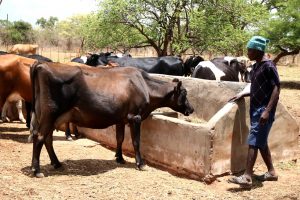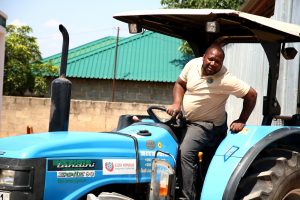Zambia
Zambia
Current situation
Although Zambia is a part of the group of economically booming “African lions”, despite its long-term increase in GDP it is still one of the world’s least developed countries (LDCs). According to the Human Development Index Zambia ranked 144th out of 189 countries in 2017. There is a huge income gap and 60% of the population lives below the poverty line.
A middle class is gradually emerging in the capital Lusaka and the Copper Belt Province in the north of the country. However, rural regions, which are home to the majority of the population, are still undeveloped. Most people work in subsistence farming, where in many cases farmers are unable to provide the recommended amount of food for the entire year, even for their families. The cause of this low productivity is the high dependence on climate change, low diversification and a lack of skilled labour.
The development of agriculture is a priority for the Zambian government in order to achieve sustainable economic growth and to reduce poverty in rural areas. Zambia has ample natural resources, water and fertile land, so this sector can be expected to develop further in the future.
CzechAid activities
According to the Czech Development Cooperation Strategy for 2010–2017, Zambia was classed as a so-called other country and the projects implemented here focused on agriculture, apprentice education and care for mothers and children. In the 2018–2023 programme Zambia is classed as a priority country and the funds allocated will gradually increase. In geographic terms projects focus primarily on the Western and Southern Provinces.
As part of its current cooperation programme CzechAid is focusing on agriculture and rural development. Activities are aimed particularly at diversifying and improving the production of small and medium-sized farmers. All areas of sustainable development will be taken into account, i.e. the economic, social and environmental aspects of intervention. Support will also be given to projects intended to improve nutrition, including nutritional diversity, improve the eating habits of risk groups of the population and prevent malnutrition.
These steps help to further reduce Zambia’s dependence on development aid, prevent poverty and hunger, and make economic growth more sustainable.
Development Cooperation Programme with Zambia:
Programme for the years 2018–2023
Bilateral Development Cooperation
on-going
- Increasing productivity and supporting the development of mango, cassava and cashew nut value chains in Western Province, Zambia
- Silvopastoral systems as a sustainable agriculture strategy to improve the livelihoods of smallholder farmers in the Southern Province of Zambia
- Livelihood stabilization and development in response to climate change, Southern Province, Zambia
finished
- Support to productive agriculture in selected provinces of Zambia
- Developing an integrated approach to farming in the Western Province of Zambia
- Improving Quality and Access to Mother and Child healthcare in Western Province, Zambia
- Enrolled Midwifery Programme for the Western Province
- Appropriate and stable fodder production for dairy cattle on the small scale farms – Introduction of holistic management of landscape and cattle animals
- Support of artificial insemination and regeneration of the gene pool of local cattle breeds
- Vocational training for vulnarable children Katongo
- Sustainable care of OVC in western Zambia
- Improving quality and access to mother and child healthcare in Western Province, Zambia II
- Appropriate and stable fodder production for dairy cattle on the small scale farms
- Vocational Training Centre for Vulnerable Youths Mongu
Agriculture and Forestry
finished
- Support to productive agriculture in selected provinces of Zambia
- Developing an integrated approach to farming in the Western Province of Zambia
- Appropriate and stable fodder production for dairy cattle on the small scale farms – Introduction of holistic management of landscape and cattle animals
- Support of artificial insemination and regeneration of the gene pool of local cattle breeds
- Appropriate and stable fodder production for dairy cattle on the small scale farms
Health
Education
Horizontal Programmes
finished
- Strengthening civic engagement to improve democratic governance in Zambia’s Western Province
- Strengthening of teaching, research and networking capacities at the University of Barotseland in Mongu for agricultural development of West Province, Zambia
- Livelihoods urban refugees project
- Improving Livelihoods through Integrated Vocational and Entrepreneurship Training and Support of Income Generating Actitvities in Mayukwayukwa and Meheba Resettlement Areas
- Economic Emancipation – Zambia
- Women in Governance – Zambia
Trilateral Development Cooperation
finished
- Strengthening civic engagement to improve democratic governance in Zambia’s Western Province
- Livelihoods urban refugees project
- Improving Livelihoods through Integrated Vocational and Entrepreneurship Training and Support of Income Generating Actitvities in Mayukwayukwa and Meheba Resettlement Areas
- Economic Emancipation – Zambia
- Women in Governance – Zambia





